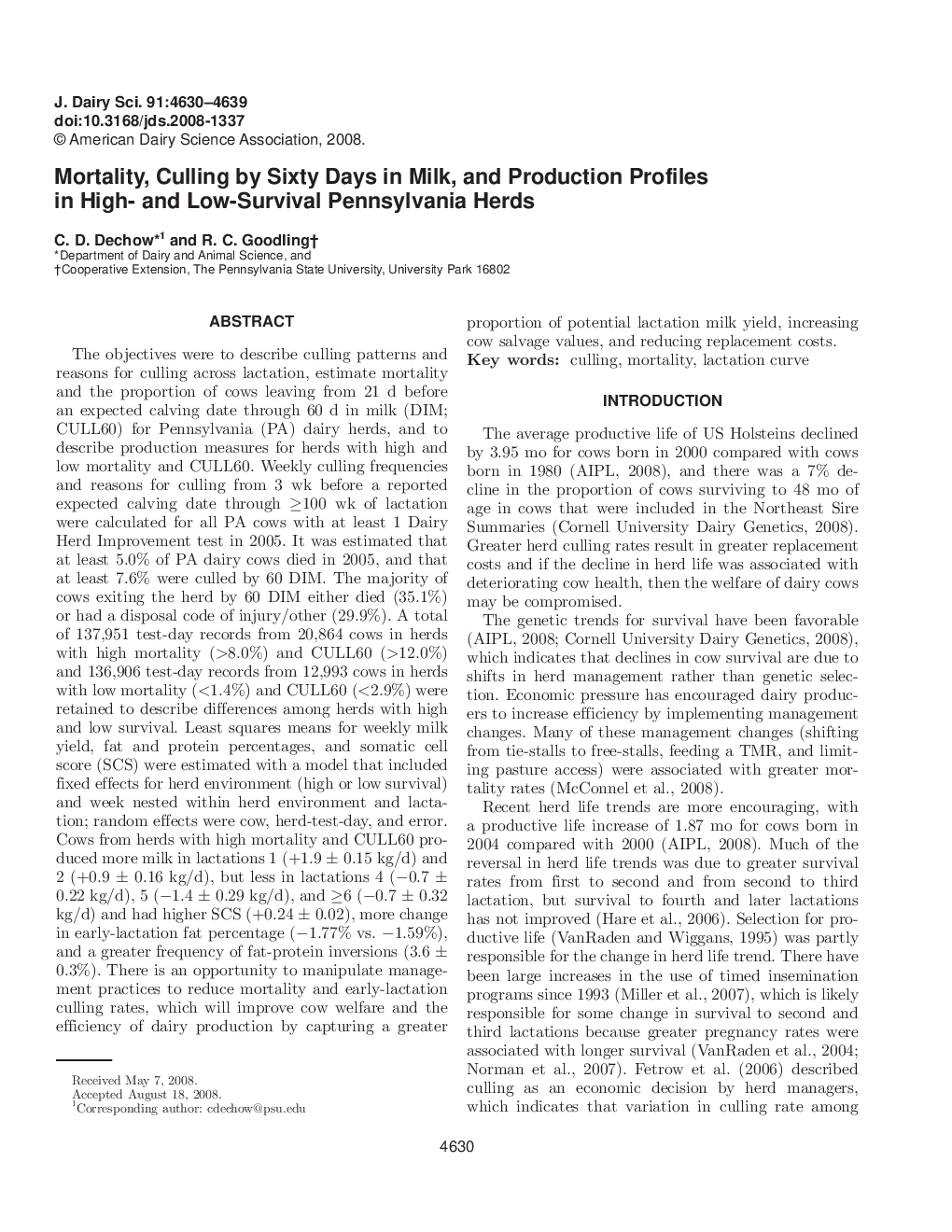| کد مقاله | کد نشریه | سال انتشار | مقاله انگلیسی | نسخه تمام متن |
|---|---|---|---|---|
| 2439800 | 1108105 | 2008 | 10 صفحه PDF | دانلود رایگان |
عنوان انگلیسی مقاله ISI
Mortality, Culling by Sixty Days in Milk, and Production Profiles in High- and Low-Survival Pennsylvania Herds
دانلود مقاله + سفارش ترجمه
دانلود مقاله ISI انگلیسی
رایگان برای ایرانیان
موضوعات مرتبط
علوم زیستی و بیوفناوری
علوم کشاورزی و بیولوژیک
علوم دامی و جانورشناسی
پیش نمایش صفحه اول مقاله

چکیده انگلیسی
The objectives were to describe culling patterns and reasons for culling across lactation, estimate mortality and the proportion of cows leaving from 21 d before an expected calving date through 60 d in milk (DIM; CULL60) for Pennsylvania (PA) dairy herds, and to describe production measures for herds with high and low mortality and CULL60. Weekly culling frequencies and reasons for culling from 3 wk before a reported expected calving date through â¥100 wk of lactation were calculated for all PA cows with at least 1 Dairy Herd Improvement test in 2005. It was estimated that at least 5.0% of PA dairy cows died in 2005, and that at least 7.6% were culled by 60 DIM. The majority of cows exiting the herd by 60 DIM either died (35.1%) or had a disposal code of injury/other (29.9%). A total of 137,951 test-day records from 20,864 cows in herds with high mortality (>8.0%) and CULL60 (>12.0%) and 136,906 test-day records from 12,993 cows in herds with low mortality (<1.4%) and CULL60 (<2.9%) were retained to describe differences among herds with high and low survival. Least squares means for weekly milk yield, fat and protein percentages, and somatic cell score (SCS) were estimated with a model that included fixed effects for herd environment (high or low survival) and week nested within herd environment and lactation; random effects were cow, herd-test-day, and error. Cows from herds with high mortality and CULL60 produced more milk in lactations 1 (+1.9 ± 0.15 kg/d) and 2 (+0.9 ± 0.16 kg/d), but less in lactations 4 (â0.7 ± 0.22 kg/d), 5 (â1.4 ± 0.29 kg/d), and â¥6 (â0.7 ± 0.32 kg/d) and had higher SCS (+0.24 ± 0.02), more change in early-lactation fat percentage (â1.77% vs. â1.59%), and a greater frequency of fat-protein inversions (3.6 ± 0.3%). There is an opportunity to manipulate management practices to reduce mortality and early-lactation culling rates, which will improve cow welfare and the efficiency of dairy production by capturing a greater proportion of potential lactation milk yield, increasing cow salvage values, and reducing replacement costs.
ناشر
Database: Elsevier - ScienceDirect (ساینس دایرکت)
Journal: Journal of Dairy Science - Volume 91, Issue 12, December 2008, Pages 4630-4639
Journal: Journal of Dairy Science - Volume 91, Issue 12, December 2008, Pages 4630-4639
نویسندگان
C.D. Dechow, R.C. Goodling,